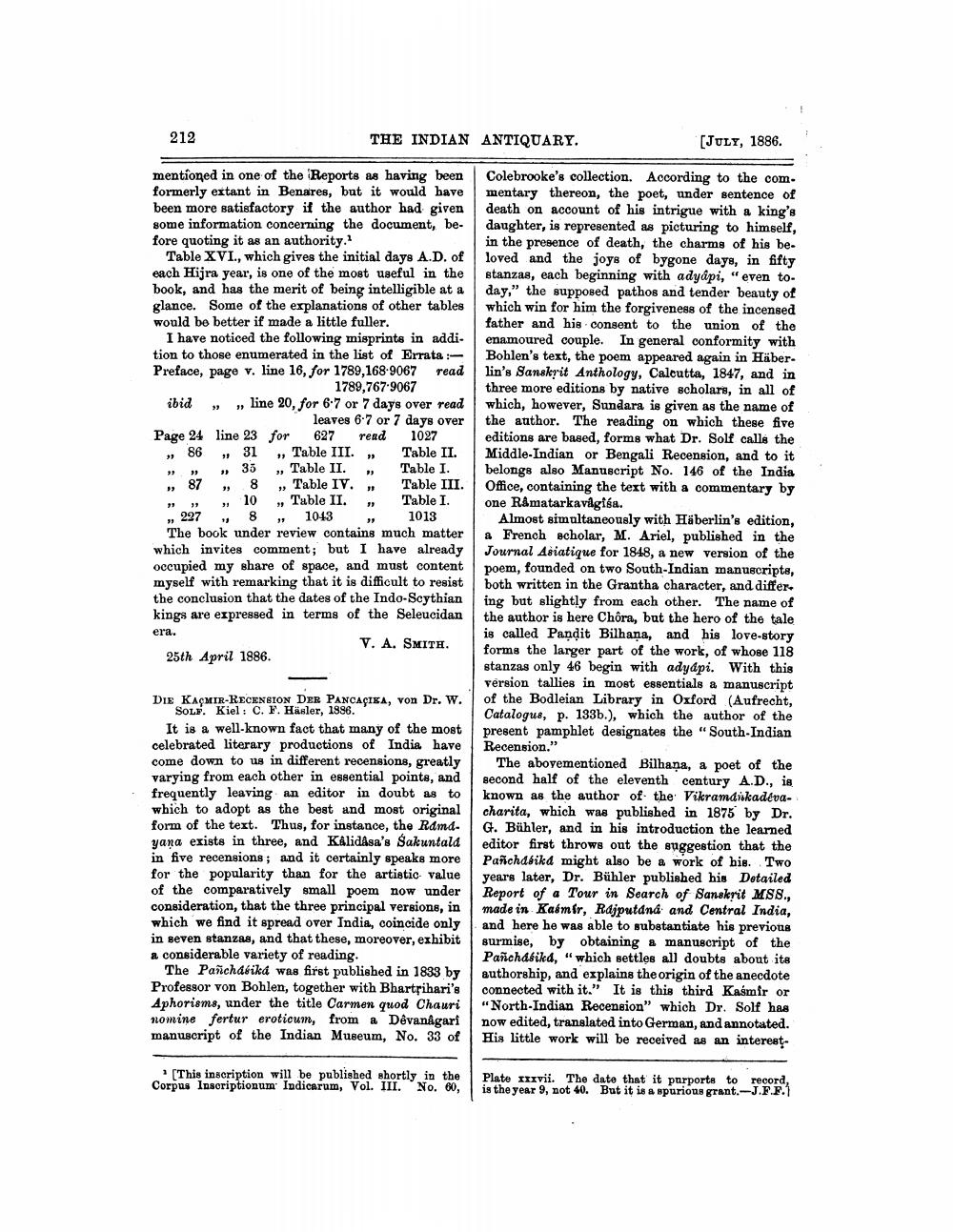________________
212
mentioned in one of the Reports as having been formerly extant in Benares, but it would have been more satisfactory if the author had given some information concerning the document, before quoting it as an authority.1
Table XVI., which gives the initial days A.D. of each Hijra year, is one of the most useful in the book, and has the merit of being intelligible at a glance. Some of the explanations of other tables would be better if made a little fuller.
ibid
I have noticed the following misprints in addition to those enumerated in the list of Errata :Preface, page v. line 16, for 1789,168-9067 read 1789,767-9067 line 20, for 67 or 7 days over read leaves 6.7 or 7 days over 627 read 1027 Table III. Table II. Table II. Table I. Table IV. " Table III. ,, Table II. Table I. 8 1043 1013 The book under review contains much matter which invites comment; but I have already occupied my share of space, and must content myself with remarking that it is difficult to resist the conclusion that the dates of the Indo-Scythian kings are expressed in terms of the Seleucidan
10
"1
33
13
23
era.
V. A. SMITH.
Page 24 line 23 for
86
31
35
39
33
87
33
33
227
33
"3
وو
31
8
25th April 1886.
THE INDIAN ANTIQUARY.
33
33
33
DIE KAÇMIR-RECENSION DER PANCAÇIEA, von Dr. W. SOLF. Kiel: C. F. Häsler, 1886.
It is a well-known fact that many of the most celebrated literary productions of India have come down to us in different recensions, greatly varying from each other in essential points, and frequently leaving an editor in doubt as to which to adopt as the best and most original form of the text. Thus, for instance, the Ramayana exists in three, and Kalidasa's Sakuntald in five recensions; and it certainly speaks more for the popularity than for the artistic value of the comparatively small poem now under consideration, that the three principal versions, in which we find it spread over India, coincide only in seven stanzas, and that these, moreover, exhibit a considerable variety of reading.
The Pañchásika was first published in 1833 by Professor von Bohlen, together with Bhartrihari's Aphorisms, under the title Carmen quod Chauri nomine fertur eroticum, from a Dêvanagari manuscript of the Indian Museum, No. 33 of
[This inscription will be published shortly in the Corpus Inscriptionum Indicarum, Vol. III. No. 60,
[JULY, 1886.
Colebrooke's collection. According to the com. mentary thereon, the poet, under sentence of death on account of his intrigue with a king's daughter, is represented as picturing to himself, in the presence of death, the charms of his be loved and the joys of bygone days, in fifty stanzas, each beginning with adyapi, "even today," the supposed pathos and tender beauty of which win for him the forgiveness of the incensed father and his consent to the union of the enamoured couple. In general conformity with Bohlen's text, the poem appeared again in Häberlin's Sanskrit Anthology, Calcutta, 1847, and in three more editions by native scholars, in all of which, however, Sundara is given as the name of the author. The reading on which these five editions are based, forms what Dr. Solf calls the Middle-Indian or Bengali Recension, and to it belongs also Manuscript No. 146 of the India Office, containing the text with a commentary by one Råmatarkavagisa.
Almost simultaneously with Häberlin's edition, a French scholar, M. Ariel, published in the Journal Asiatique for 1848, a new version of the poem, founded on two South-Indian manuscripts, both written in the Grantha character, and differ. ing but slightly from each other. The name of the author is here Chôra, but the hero of the tale is called Pandit Bilhana, and his love-story forms the larger part of the work, of whose 118 stanzas only 46 begin with adyapi. With this version tallies in most essentials a manuscript of the Bodleian Library in Oxford (Aufrecht, Catalogus, p. 133b.), which the author of the present pamphlet designates the "South-Indian Recension."
The abovementioned Bilhana, a poet of the second half of the eleventh century A.D., is known as the author of the Vikramánkadévacharita, which was published in 1875 by Dr. G. Bühler, and in his introduction the learned editor first throws out the suggestion that the Pañchdbika might also be a work of his. Two years later, Dr. Bühler published his Detailed Report of a Tour in Search of Sanskrit MSS., made in Kasmir, Rajputáná and Central India, and here he was able to substantiate his previous surmise, by obtaining a manuscript of the Pañchábikd, "which settles all doubts about its authorship, and explains the origin of the anecdote connected with it." It is this third Kasmir or "North-Indian Recension" which Dr. Solf has now edited, translated into German, and annotated. His little work will be received as an interest
Plate xxxvii. The date that it purports to record, is the year 9, not 40. But it is a spurious grant.-J.F.F.1




